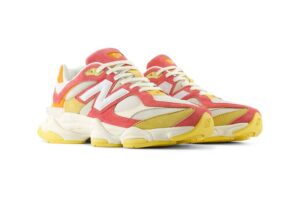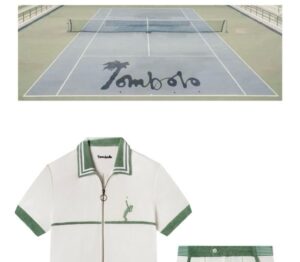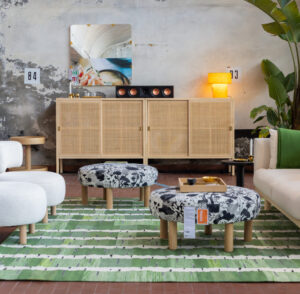Roman Mykhailov’s journey as an artist began with the sky

It’s an image he returns to often: the expanse above his hometown of Chuhuiv in eastern Ukraine. Wind, clouds, the eerie stillness of a rural field before a storm—these early impressions didn’t just shape his sense of space and motion; they taught him something elemental about freedom. “When you’re a child,” he says, “you don’t understand politics or philosophy. But you know what feels real.”
Born in 1985, Mykhailov came of age as his country lurched out of Soviet collapse into the unstable promise of independence. For a young boy with a restless streak and an instinct for beauty, art became both rebellion and refuge. “I got into trouble a lot,” he says with a smile, “so they sent me to art school. I think they hoped it would calm me down.” It didn’t—but it did give him a language.
Today, that language—restless, searching, spare—has matured into a body of work that defies easy definition. Based in Kyiv, Mykhailov straddles the divide between academic tradition and personal rupture. His practice ranges from luminous abstract paintings to darkly symbolic installations constructed from burned wood and industrial debris. Across formats, his work hums with contradiction: violence and grace, mourning and renewal, memory and forgetting.
In conversation, Mykhailov is calm but never performative. His thoughts unfold slowly, with long pauses that suggest ongoing inner edits. “I don’t want to be understood too quickly,” he says. “I don’t make work for instant reaction. I make it to outlast a moment.”
The Landscape Within
Mykhailov’s earliest influences weren’t galleries or mentors—they were elements. “Kharkiv region is flat, endless. You look out and see horizon after horizon. It teaches you about scale.” He talks about staring at the sky, watching clouds shift light across fields. This wasn’t romanticism—it was orientation. “Space was my first teacher,” he says.
When he began painting seriously in his late teens, those lessons reappeared in abstract seascapes—huge canvases of layered blue, gray, and white. “They weren’t about the sea,” he says, “they were about how light breaks over emptiness. It was how I learned to break form.”
His early exhibitions in Kharkiv reflected this search for a visual language unburdened by realism. The academic training he received at the Kharkiv State Academy of Design and Arts had instilled classical techniques, but he treated them as tools, not commandments. “In the academy, you copy. Outside, you invent. I always tried to keep a foot in both worlds.”
By 2015, his approach had matured into an aesthetic of subtraction—paring away narrative, symbol, and sentiment to leave raw material, raw gesture. That year, his series Burnt Earth, which used scorched wood and charred metal, won attention from the Saatchi Gallery’s international art prize. Recognition followed—exhibitions in Kyiv, nominations for the PinchukArtCentre Prize—but Mykhailov never moved into the commercial center. “It’s not a career for me,” he says. “It’s a problem I’m working through.”
Art and the War Machine
Ukraine’s political instability—especially since the 2014 Maidan Revolution and the annexation of Crimea—has turned many artists into reluctant chroniclers of violence. Mykhailov doesn’t reject this role, but he’s wary of aestheticizing trauma.
“After 2014, war was in everything,” he says. “Not just in images, but in materials, in atmosphere.” His installations during this period were stark: blackened canvases, rusted rebar, fragments of military netting. But rather than depict war directly, he worked with its residue. “I wasn’t painting soldiers or tanks. I was showing what gets left behind—the silence, the dust, the broken surface.”
He recounts finding discarded shell casings near the frontlines and integrating them into sculpture. “They’re ugly objects. But that’s the point—they don’t belong in a gallery. I wanted viewers to feel that discomfort.”
And yet, Mykhailov resists being cast solely as a war artist. “I don’t want to be useful in that way,” he says. “Artists aren’t medics. We don’t heal the wound—we describe it.”
In 2022, when Russia launched its full-scale invasion, everything changed again. Like many Ukrainians, Mykhailov fled west briefly, then returned. “I didn’t know if I’d ever paint again,” he admits. “I thought: maybe the work is over. Maybe now we just survive.”
But gradually, something shifted. “The war didn’t end, but the way I saw it changed. Before, I painted loss. Now I try to project life.”
Between Craft and Chaos
Much of Mykhailov’s tension as an artist comes from the gap between mastery and intuition. He is classically trained, with deep respect for Renaissance techniques and modernist composition. And yet, his recent work often appears improvised, even brutal.
“I believe in craft,” he says. “But not in perfection.” He talks about learning to mix pigments by hand, how temperature and air affect drying. But he also scorches canvases, smashes frames, lets decay set in. “Destruction is part of the form,” he says.
His 2023 series Black Garden, exhibited quietly in a small Kyiv studio, features flowers sculpted from melted plastic, soot, and thread. They’re fragile, haunting, grotesque—and unmistakably human. “They’re like people after trauma,” he says. “Not what they used to be. But still here.”
For Mykhailov, these contradictions are not just aesthetic—they’re ethical. “We live in a broken country. If my work is too clean, too resolved, it’s false. I want it to carry the same damage that we do.”
That damage is not always visible. Many of his projects go unrealized: sketches in notebooks, test pieces stacked in the corner of his studio. “I don’t show everything. Some things aren’t ready. Some never will be.” He shrugs. “That’s okay.”
Finding the Audience
In a cultural climate saturated with immediacy, Mykhailov’s patience is radical. “I’m not making Instagram content,” he laughs. “I don’t want likes. I want someone to see a piece years from now and feel something shift.”
Still, he acknowledges the difficulty of reaching viewers in wartime. Many galleries have closed, and collectors are scarce. “There’s less space for slow art,” he says. “But maybe that’s when it’s most needed.”
He’s also critical of how international attention often simplifies Ukrainian art into symbols of resilience. “Yes, we’re surviving. But we’re also thinking, doubting, changing. Don’t reduce us to heroes.”
Asked whether he considers himself a political artist, he pauses. “Everything is political now. Even silence.”
But resistance, for him, doesn’t mean slogans. It means staying. Making work when it seems pointless. Insisting on nuance when everything demands certainty.
“I don’t want to make propaganda,” he says. “I want to make space. For fear. For mourning. For imagination.”
After the Smoke
In the end, Mykhailov returns to the sky.
He’s begun a new series of abstract works in oil and wax—smeared, luminous fields of gray-blue, pale gold, ash white. “They’re not about war,” he insists. “They’re about what’s after. What happens when the smoke clears.”
He’s not sure when, or where, these works will be shown. He doesn’t mind. “Exhibitions are nice. But they’re not the point.”
The point, for him, is to keep moving. To stay honest. To resist simplicity.
As we finish our conversation, he looks out the window at a low Kyiv sky. It’s raining—soft, insistent. “The light here,” he says, “is always changing. That’s what I try to follow. Not ideology. Just light.”
No comments yet.









